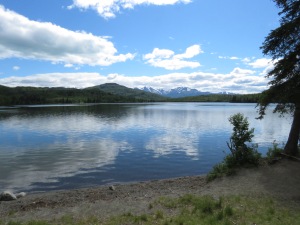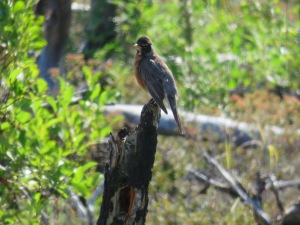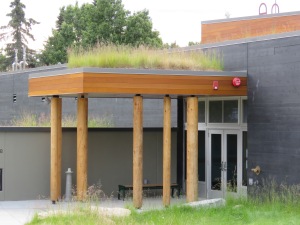Ah, the joys of camping with the mosquitoes and flies. I think the flies are more tenacious and worse than the mosquitoes.
We decided to take Doodlebug (the dog) for more camping experience and adjustment to life in a van. We are still trying to decide whether to take the van and head outside this winter.
With sun in the forecast, we headed to Seward and decided to camp at Forest Service Trail River campground on the road to Seward. This campground has 91 sites, so we thought we could surely find one site for the night. Luckily we had plenty of sites to choose from, like 80+. However, we were surprised how many sites had been reserved for the previous weekend – almost all. This apparently is a popular campground.
There are three camp loops – the River Terrace Loop, the Spruce Woods Loop, and the Eagle Point Loop. Intrigued by the name, we went straight to the Eagle Point loop (having never been to the campground before) and found a nice site. No eagles but lots of song birds out and about, including a Yellow-rumped Warbler with a nest nearby.
However, I am getting ahead of myself. One our way to the campground we did make a stop at Tern Lake. This is one of our favorite spots on the Kenai Peninsula -at any time of year. We parked at the day-use area and walked a portion of the old Sterling Highway. You could see where people have driven up the road and camped along side the road. We even found an abandoned car there – a bit spooky.
We always look for an American Dipper in the swift current at the bridge, but alas no luck. I did observe some ducklings searching the river for food. On the lake itself, we observed a Common Loon bathing – vigorously splashing around. There were also several hatch year (born this year) Arctic Terns, a female American Widgeon with four her ducklings in tow, and in the mix was a beautiful Red-necked Grebe.
Once at the campground we decided to check out the other loops and walked down to the day-use area which fronts the Kenai Lake. Of all the times we have passed by, I have never see any boats on the water. I wonder why? We decided to camp the next night in the Spruce Woods loop. And, the name fits – a nice site in the woods. We like this loop the best.

Saw about three Gray Jays flying to and from a stump grabbing something in their bill. Never did quite figure out what it was. Something black and sticky.
On day two of our trip, we ventured into Seward. We had to check out a few of the birding hot spots around Seward; a house off Nash Road where the owner has a number of bird feeders, the Nash Road ponds, the end of Nash road, and the lagoon in town. Surprisingly there weren’t a lot of birds. Maybe these places are better for birds in the winter time?

This is a pond/wetland located adjacent to the Seward Highway. There is a boardwalk leading out from the parking lot. We have seen a nesting Trumpeter Swan pair in the past, but no evidence of swans this year. I love this wetland.

Large wetland along Nash Road near Seward. Trumpeter Swans general nest here too, but didn’t see any.

At the end of Nash Road is a large parking area, or at least there was. It is now a stockpile of gravel and large boulders. Plus there is this jack-up rig.

Common Goldeneye female roosting near the pond along the Seward Highway in town. This was the only bird species observed on the pond. Guess birds like it here better in the winter.
We parked near the Sea Life Center and walked along a ocean-side path fronting the city campground full of humongous motor homes. I don’t see how people can stand to camp within ten feet of another camper. Not my idea of camping. Essentially you are camping in a large parking lot. May as well be camping at Fred Meyer’s or Walmart. Not that Seward has either. I like to have nature next to me. Oh well, one person’s ideal camping spot is not necessarily another person’s ideal.

This hatch-year Black-billed Magpie was being harassed by hatch-year Gray Jays in a tree at my brother’s house in Seward.
After a lunch at Zudy’s which was good. We hiked from Lowell Point to Tonsina Creek. Doodlebug joined us, but we probably should have left her at my brother’s house. I forgot how much of an elevation gain and descent there is on the trail. She was dragging at the end, but she was a real trooper and stayed with us. Lots of people out enjoying the beautiful sunny, warm day. After dinner at “The Cookery” we drove back to the campground and our new site in the Spruce Wood Loop. No other campers nearby. Sweet!!!
In the morning we decided to hike the Victor Creek Trail. This trail has a gradual ascent (with plenty of switchbacks) through the forest. Lots of different fungi along the way. There were some birds heard singing, but not much seen except for several Wilson’s Warblers. I think they may have had a nest nearby.
Once we got out of the forested area, the trail was hidden by tall grasses. Since bears utilize the area (although no bear scat seen on the trail) we decided to turn back and not take any chances of a surprise bear encounter on or near the trail. So back down we went. There were a lot of ripe blueberries along the trail and we sampled them as we traversed the mountainside.

Lots of fungi along the trial. Don’t know what this one is, or any of the others for that matter. Need to buy a book.
Some of the plants and fungi we observed along the trail. More fungi than anything else.

Jack barely visible through the tall grasses. We decided to turn around here because we didn’t want to worry about running into bears unannounced.
After we finished hiking the Victor Creek Trail we drove to Quartz Creek campground (another Forest Service Campground) situated along Kenai Lake, near Cooper’s Landing. This campground gets heavy use and was filled up by around 5:00 pm that night. Luckily we found a nice campground the mosquitoes and flies were willing to share with use. We spent part of the afternoon sitting in our campsite reading. We could only take so much buzzing and biting from the flies and mosquitoes and decided to walk the boardwalk and nearby road looking for birds.

This large pile of bear scat was found near the boardwalk. Looks like the bear was eating red currents. Luckily we didn’t see any bears. Always a plus when you are hiking.
Surprisingly the campground was quite birdy. We encountered at least ten (10) different species in the afternoon, including two (2) Brown Creepers. Brown Creepers are always a nitce find as one does not get the reward of seeing a Brown Creeper often. Near the river I heard a Northern Waterthrush and eventually found it in a tree gathering caterpillars. We didn’t spot the American Dipper family that uses the bridge support structures for nesting.

Female Harlequin duck with her ducklings. She had at least five. Cute to watch them forage in a shallow area along Quartz Creek.
The following morning we packed up and then went for another short walk before heading back to Homer. This time we did see the American Dipper dipping into the fast moving water. The bird was using snags on which to perch and to then dip down into the water in search of food. With the river so high there isn’t as much habitat available for these birds to feed.

American Dipper. There is usually always a pair that nests under the Quartz Creek bridge. This bird may have been one of the pair or its offspring.
We had a great time camping. The weather was nice and the birding great despite the bugs. However, I will say that I’ve been in worse “bug” conditions in states in the lower 48. All in all, it was a great four days to be outdoors and …
“It’s Always A Great Day to Bird”
P.S. For those of you who are interested in fungi, on August 26-28 is the Girdwood (AK) Fungus Fair. Check it out: http://www.fungusfair.com/. In addition, the U.S. Forest Service has produced a brochure titled “Mushrooms of the National Forests in Alaska”. You can download the brochure at: http://www.fs.usda.gov/Internet/FSE_DOCUMENTS/stelprdb5414170.pdf. If you know the names of the mushrooms in the photographs on this blog, please let me know.




































































































































Recent Comments